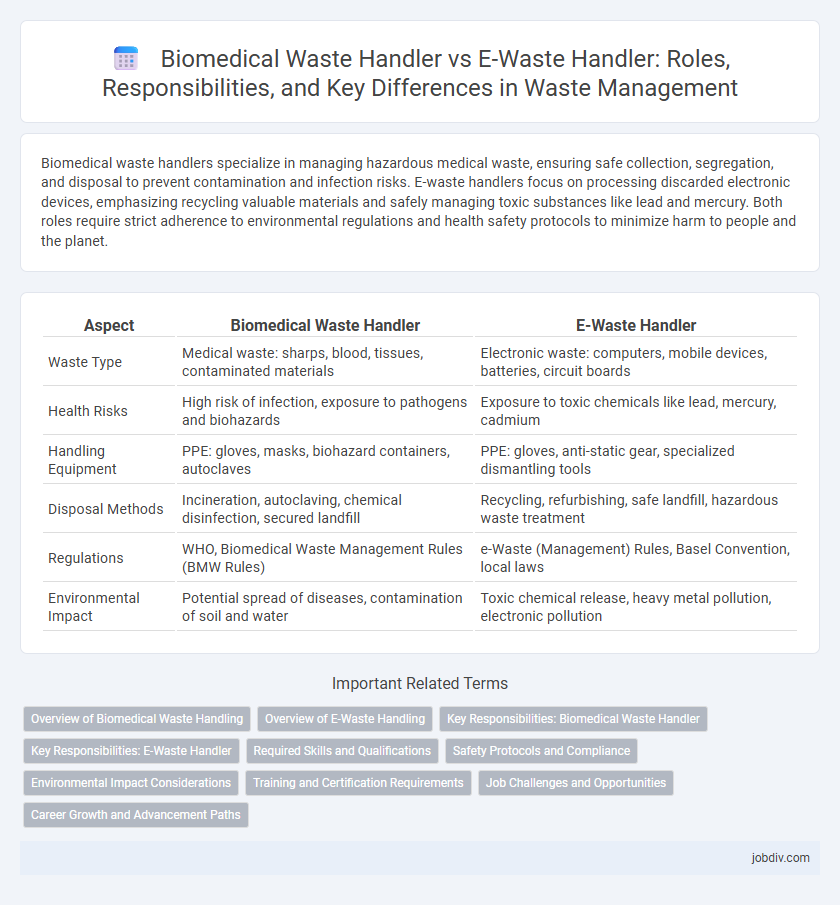Biomedical waste handlers specialize in managing hazardous medical waste, ensuring safe collection, segregation, and disposal to prevent contamination and infection risks. E-waste handlers focus on processing discarded electronic devices, emphasizing recycling valuable materials and safely managing toxic substances like lead and mercury. Both roles require strict adherence to environmental regulations and health safety protocols to minimize harm to people and the planet.
Table of Comparison
| Aspect | Biomedical Waste Handler | E-Waste Handler |
|---|---|---|
| Waste Type | Medical waste: sharps, blood, tissues, contaminated materials | Electronic waste: computers, mobile devices, batteries, circuit boards |
| Health Risks | High risk of infection, exposure to pathogens and biohazards | Exposure to toxic chemicals like lead, mercury, cadmium |
| Handling Equipment | PPE: gloves, masks, biohazard containers, autoclaves | PPE: gloves, anti-static gear, specialized dismantling tools |
| Disposal Methods | Incineration, autoclaving, chemical disinfection, secured landfill | Recycling, refurbishing, safe landfill, hazardous waste treatment |
| Regulations | WHO, Biomedical Waste Management Rules (BMW Rules) | e-Waste (Management) Rules, Basel Convention, local laws |
| Environmental Impact | Potential spread of diseases, contamination of soil and water | Toxic chemical release, heavy metal pollution, electronic pollution |
Overview of Biomedical Waste Handling
Biomedical waste handlers manage hazardous medical materials such as infectious waste, sharps, and pathological waste, ensuring compliance with strict health and safety regulations to prevent contamination and disease transmission. These professionals utilize specialized containers, segregation protocols, and authorized disposal methods like incineration or autoclaving to treat and eliminate biomedical hazards safely. Their role is critical in healthcare facilities to maintain sanitary conditions and protect both public health and the environment from biohazard risks.
Overview of E-Waste Handling
E-waste handling involves the safe collection, dismantling, and recycling of discarded electronic devices to prevent toxic materials like lead, mercury, and cadmium from contaminating the environment. Specialized e-waste handlers follow strict protocols for segregating hazardous components and recovering valuable metals such as gold, silver, and copper. Efficient e-waste management reduces landfill burden and supports sustainable resource recovery in contrast to biomedical waste handlers who focus primarily on infectious and medical waste disposal.
Key Responsibilities: Biomedical Waste Handler
Biomedical waste handlers are responsible for the safe collection, segregation, transportation, and disposal of hazardous medical waste such as sharps, pathological waste, and contaminated materials from healthcare facilities. They ensure compliance with regulations related to infection control and environmental safety by using specialized protective equipment and following strict protocols. Proper biomedical waste management reduces the risk of disease transmission and environmental contamination.
Key Responsibilities: E-Waste Handler
E-Waste handlers are responsible for the collection, segregation, and safe disposal of electronic waste, including computers, mobile phones, and batteries, ensuring compliance with regulations like the E-Waste Management Rules 2016. Their key tasks involve dismantling devices to recover valuable materials such as precious metals, preventing hazardous substances like lead and mercury from contaminating the environment. Proper e-waste management mitigates electronic pollution and supports resource recovery and recycling initiatives.
Required Skills and Qualifications
Biomedical waste handlers require knowledge of biohazard safety protocols, infection control, and proper use of personal protective equipment (PPE) to manage infectious and hazardous medical waste safely. E-waste handlers must possess skills in electronic component identification, safe dismantling techniques, and knowledge of environmental regulations concerning hazardous substances like lead and mercury. Both roles demand certifications in waste management and compliance with regulatory standards to ensure safe disposal and environmental protection.
Safety Protocols and Compliance
Biomedical waste handlers follow stringent safety protocols, including the use of personal protective equipment (PPE) and adherence to the Biomedical Waste Management Rules, 2016, ensuring safe disposal to prevent infection risks. E-waste handlers comply with the E-Waste Management Rules, 2016, focusing on safe dismantling and recycling processes to minimize exposure to hazardous substances like lead and mercury. Both roles demand rigorous training and regular audits to maintain regulatory compliance and safeguard worker health and environmental safety.
Environmental Impact Considerations
Biomedical waste handlers manage hazardous materials containing infectious agents and chemicals, requiring strict protocols to prevent environmental contamination and disease transmission. E-waste handlers focus on safely dismantling and recycling electronic components to recover valuable metals while minimizing toxic substance release, such as heavy metals and persistent organic pollutants. Environmental impact considerations emphasize containment and treatment in biomedical waste and advanced recycling technologies and proper disposal methods for e-waste to reduce soil, water, and air pollution effectively.
Training and Certification Requirements
Biomedical waste handlers must complete specialized training in infection control, hazardous material management, and comply with government-mandated certifications such as OSHA or WHO guidelines. E-waste handlers require certification programs centered on safe dismantling, recycling techniques, and adherence to environmental regulations like R2 or e-Stewards. Both roles demand continuous education to stay updated on evolving safety protocols and disposal technologies.
Job Challenges and Opportunities
Biomedical waste handlers face strict regulatory compliance challenges due to hazardous materials and infection risks, requiring specialized training and protective equipment. E-waste handlers deal with complex disassembly of electronic components and hazardous substances like lead and mercury, necessitating expertise in safe recycling techniques and data security. Both sectors offer growing job opportunities driven by increasing waste generation and environmental regulations promoting sustainable disposal and resource recovery.
Career Growth and Advancement Paths
Biomedical waste handlers specialize in managing hazardous medical materials, offering career growth through certifications in infection control and biohazard safety, often advancing to supervisory or hospital compliance roles. E-waste handlers focus on recycling and safely disposing of electronic components, with advancement paths including technical expertise in electronics repair, environmental management, and roles in sustainability consulting. Both careers demand adherence to strict regulations, but biomedical waste handling typically requires more healthcare-specific knowledge, while e-waste management emphasizes technological and environmental skills.
Biomedical Waste Handler vs E-Waste Handler Infographic

 jobdiv.com
jobdiv.com